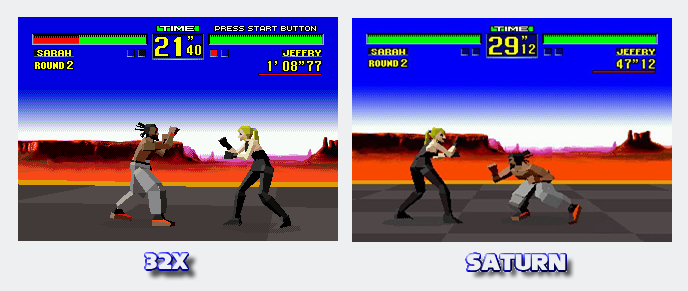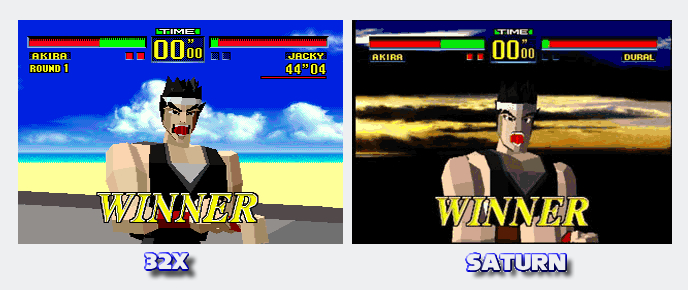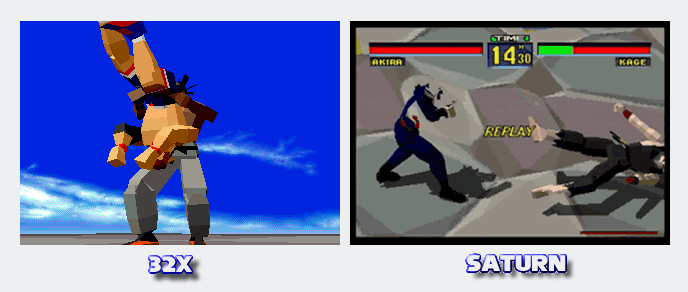Diehard fighting fans around the world stand on strict sides when it comes to Virtua Fighter. Either you love it or you hate it. As the first breakthrough 3D brawler, AM2’s incredible arcade muncher was so technically ahead of the competition that its board was co-developed with Lockheed Martin. Think it hasn’t been influential? Well, a Virtua Fighter arcade unit has been on display at the Smithsonian Institute’s Permanent Research Collection on Information Technology Innovation since 1998. How’s that for leaving your mark on a genre?
Sega was obviously pretty proud of its little polygonal baby. It packed it along with the new Saturn console in 1995. While the series has never enjoyed the massive popularity in America that it has in Japan, it has commanded enough of a following that each game, sometimes multiple versions of them, has been released in the U.S. So eager was Sega to promote it, that a version was even made for the 32X, to many rolling eyes and sarcastic snickers. How could AM2 squeeze that immensely powerful (at the time) coin-op into a cartridge? Moreover, how on Earth could it ever hope to stand next to the Saturn version? After all, wasn’t the Saturn more powerful than the much-maligned mushroom add-on? Wasn’t the 32 just supposed to be a low cost alternative to the much more powerful next gen console?
Well, Sega-16 sat down with both versions (we’re comparing the 32X Virtua Fighter to the Saturn original, not Remix), and gave them some intense playtime, both in single-player mode and against a human opponent. We went through each of the game’s modes, tested the music and voice overs, and ran through every inch of the gameplay. Our findings were quite surprising.
The Differences
Presentation: I still cringe when I think of the flicker that plagued the Saturn version, even in replays. It was a tell-tale sign of a rushed product (thank you Sega for that surprise hardware launch!), and we all knew the Saturn was capable of much more. The 32X game, not subjected to the same maddening schedule as its CD counterpart, hardly suffers from this problem. There is almost no flicker at all, while you play nor during replay. Sure, Sega would correct this ailment on the Saturn with the release of Virtua Fighter Remix, but that’s what second chances are for. The 32X rendition, on the other hand, is smooth and solid, offering gamers some decent, though scaled back visuals that still manage to retain all the magic and personality of the arcade original.
All the modes from the Saturn game (arcade & vs.) are present on the 32X, and even the options menu has made the transition intact. Adjust your life bar (or your foes), the time limit, ring out, etc. Even the secret option menu has been included!
Edge: 32X
Graphics: Upon first booting up both games, you’re greeted with the same intro of several of the cast battling each other. The whole sequence is there in the 32X cart, and everything is surprisingly similar. That is, until you’re treated to that side shot of Akira, just before the intro ends. Remember how you sneered at his polygonal “claw,” that clunky box that the Model 1 hardware tried to pass off as a hand? Well, it’s a mallet on the 32X. There is no definition of fingers or toes, and the step down in overall polygons used in each model is readily apparent. The 32X simply cannot compete here, and I think AM2 was quite aware of this. Knowing the limitations of cartridges, the developers obviously sought to compensate the lack of raw processing power with seamless gameplay.
Another problem with the 32X game is that the graphics are much grainier and less-detailed. For example, Sara Bryant’s stage looks nice, but pales in comparison to the Saturn rendition. Even the floor looks worse. Moreover, the already bare backgrounds manage to impress even less, and you’re constantly reminded of the lesser power of the 32X. The Saturn cast a big shadow over it, and Virtua Fighter, while quite competent, just doesn’t have the muscle to compete.
Edge: Saturn
Sound/Music: I know what you’re thinking: Game over. The Saturn wins here, hands down. That was my first impression as well, and while the 32X’s sad sound chip cannot compare to the Saturn’s incredible CD audio, it wasn’t as cut and dry as you might think. Virtua Fighter 32X has all the voice work of the arcade, and they are exceptionally clear. In fact, so clear are they that I found myself spending more time than should be allowed just listening to them. I could not believe that this was the 32X I was hearing; there were no scratchy voices, no muffled sounds. Everything was clear as a bell, and it was darn impressive.
Sadly, the same cannot be said for the soundtrack. One of the things I most love about the original Virtua Fighter on Saturn is it’s godly remixed red book soundtrack. Superior to even the original coin-op, it’s masterfully scored and wonderfully suited for each character and stage. The 32X did its best to capture that majesty, but fell woefully short. Though all the songs are present, most of them sound tinny and weak, and the overwhelming majority of the themes are cut by more than half their original length. Listening to Jacky’s Theme, for example, was especially excruciating, given that it’s my favorite in the whole score. The entire solo is gone, and the song loops all too quickly for my taste. Every single tune has been neutered, and given the 32X’s shady reputation regarding audio, it becomes painfully apparent that most of that criticism is warranted. There is simply no comparison here, but I at least give the cartridge some kudos for including the whole soundtrack, inferior though it may be.
Jacky’s Theme (Saturn MP3 file) Jacky’s Theme (32X MP3 file)
Edge: Saturn
Gameplay: It seems pretty obvious from the start that the Saturn version sports better graphics and sound. Does it play better? Hardly. I love the Saturn pad (the Japanese one, please), but the Genesis 6-button controller more than holds its own. Regardless of which version you choose, you’re going to be treated to some solid gameplay. Both controller’s D-pads are very responsive, and the button layouts are almost identical. Some people may complain that the Genesis controller is too small, but that seems more like nitpicking to me.
AM2 was able to squeeze all 700+ moves into the 32X cart, and thanks to some slick presentation, the gameplay comes off much cleaner visually. The inferior graphics aren’t much of a hindrance, but the low frame rate is, and this can cause the control to lose a bit of fluidity. On the bright side, some new camera angles have been added in the replays, and the virtual absence of flicker overall makes playing highly enjoyable. There are also two new exclusive play modes- ranking and tournament- that add a much-needed level of depth to the gameplay. Being able to take on up to eight of your pals in the tournament mode is lots of fun, and this gives the cartridge port the edge, in my opinion. The more modes of play, the better, and Virtua Fighter 32X has twice as many as the Saturn version does, end of story.
Edge: 32X
Other: What else is there left to say? You got the Saturn game along with your system, which seemed like cold comfort, considering the hefty price tag at launch. Instead of the killer app of the year, you got a rushed port which looked downright ghetto compared to the Playstation’s Toshinden. Sure, we all know that Virtua Fighter played rings around Takara’s all-flash-and-no-substance feast for the eyes, but hindsight is 20/20, right? On the other hand, no one expected the 32X to pull off the game as well as it did, and this makes the 32X port the stand-out version of the two. It was a prime example of what could be done on the hardware, and made many naysayers do a double take. That’s an important distinction, given the hammering the 32X was taking in the press at the time. Add in that cool little trainer’s pack promotional item you got for reserving the game (it included a VHS tape with tricks, a $20 coupon towards the game’s purchase, a t-shirt, and a chance to win the arcade game), and Virtua Fighter 32X didn’t seem like such a bad way to go at the time. It wasn’t like there was a deluge of games to buy for the thing anyway.
I have to give the upper hand here to the 32X, since Sega had its face full of egg from the Saturn port. AM2 seemed to initially have a better grasp of the 32X’s hardware than the Saturn’s, which is ironic when you consider the incredible quality of their later efforts like Virtua Fighter 2 and Virtua Cop. The sad part is that all the 32X’s efforts were in vain, as it was quickly overtaken and replaced by the Saturn.
Edge: 32X
Final Assessment
In the end, the 32X rendition of Virtua Fighter beats out the Saturn version. I bet you didn’t see that coming! Seriously folks, when you put them both through their paces and get to the heart of the matter, the Saturn disappointed with a game it should have easily handled, while the 32X produced a port no one thought was possible. Considering how dated the Genesis was at this point, and how much weaker the 32X was compared to the newer 32-bit hardware, the feat is all the more impressive. I only wish the little mushroom could have been given more of a chance, as I’m sure developers could have produced some awesome stuff with a bit of time and dedication. Too bad we’ll never know.




Recent Comments